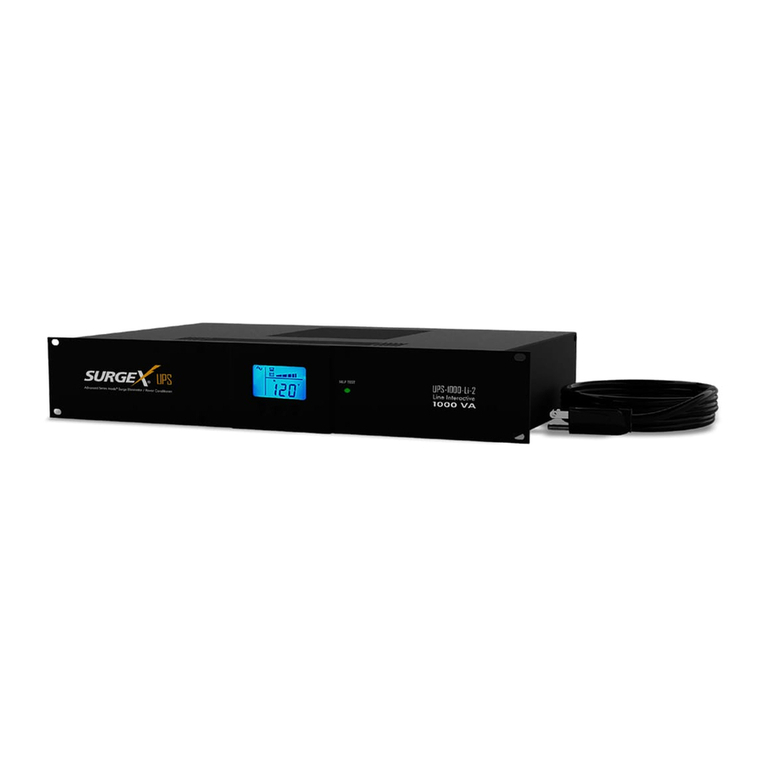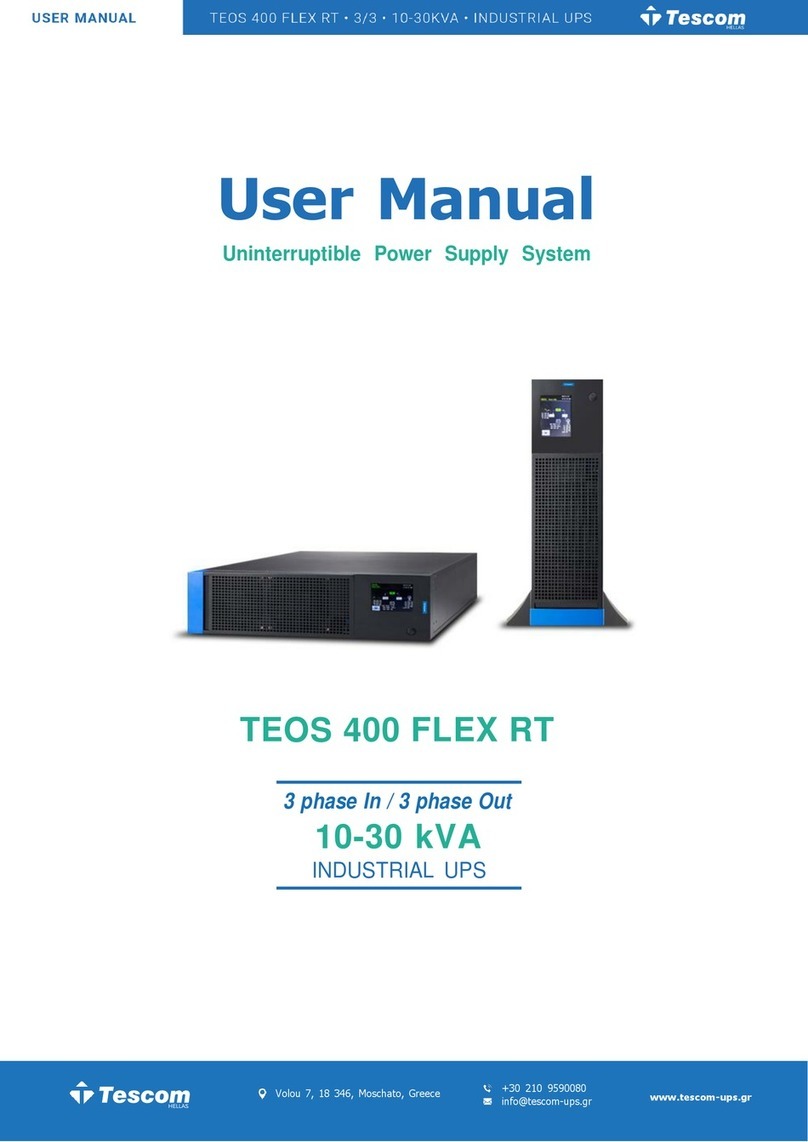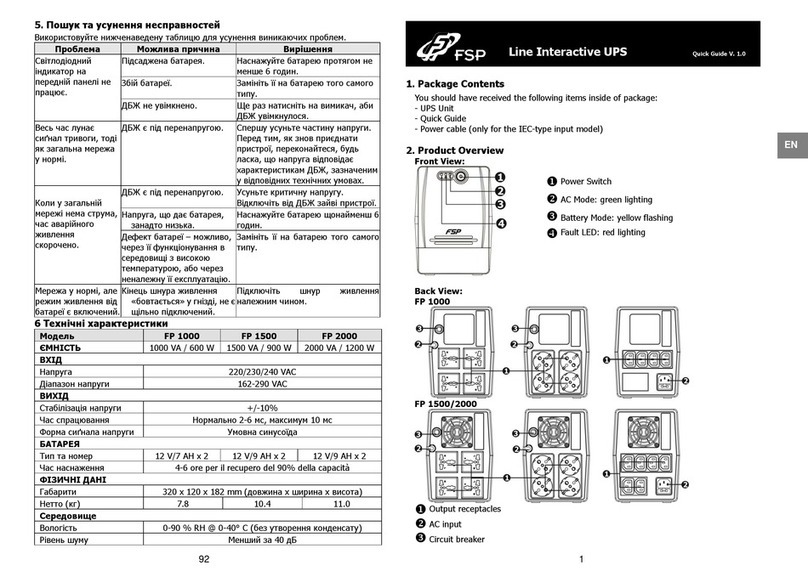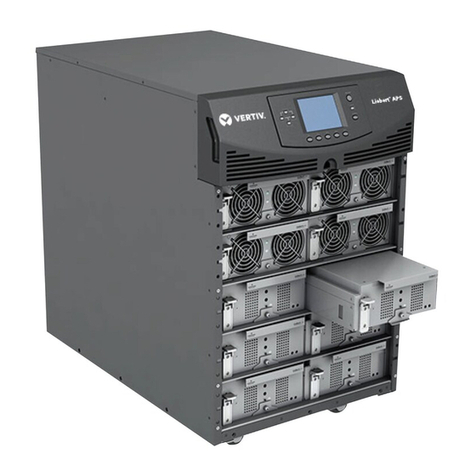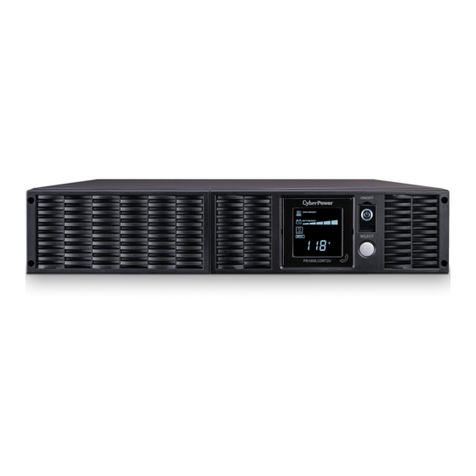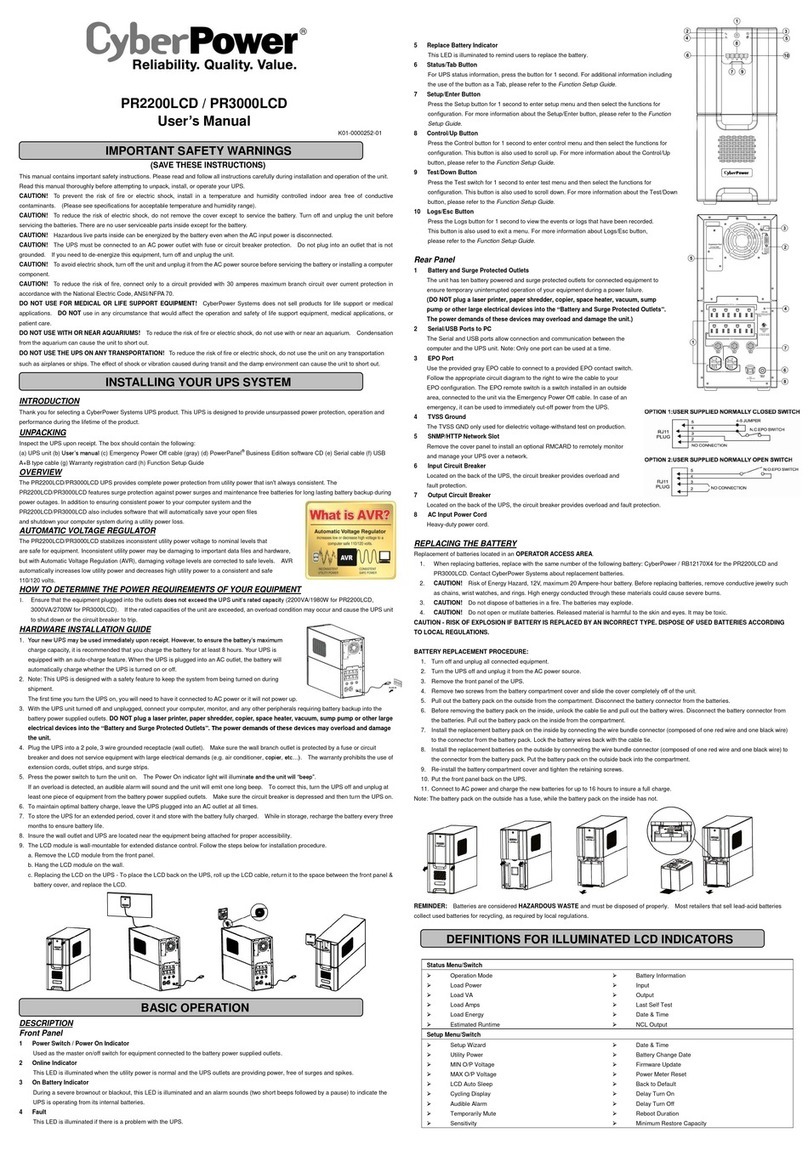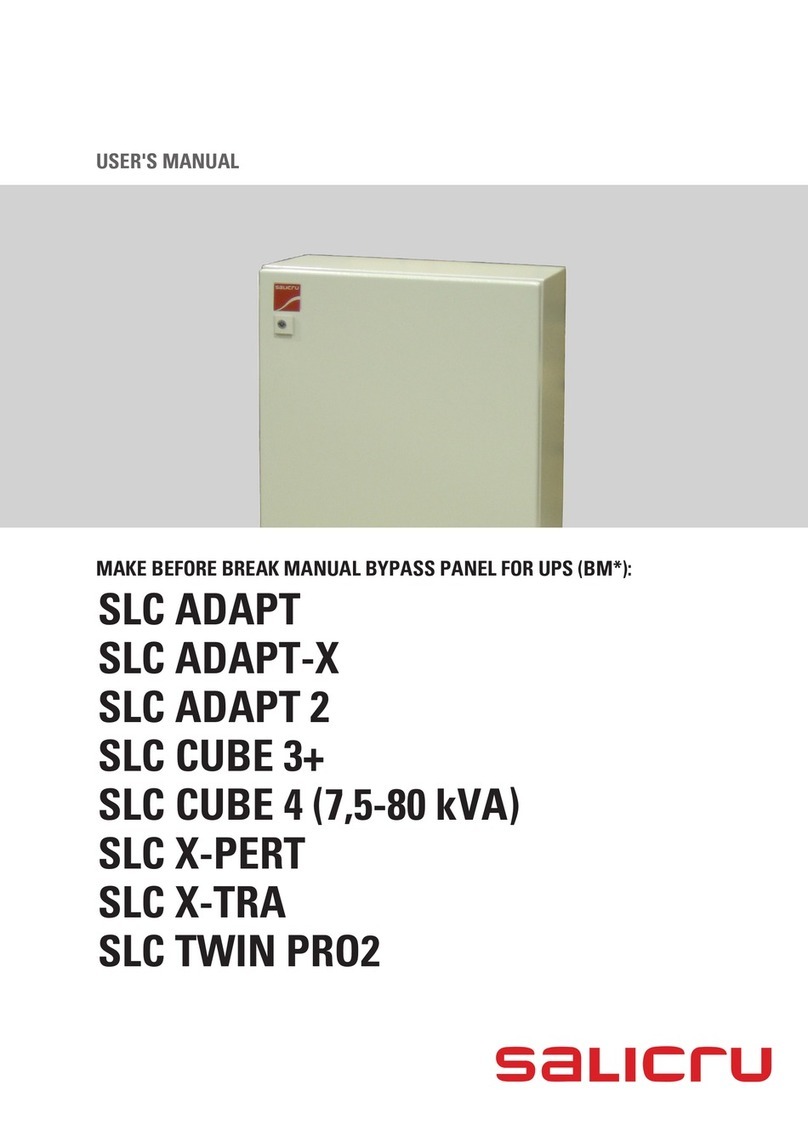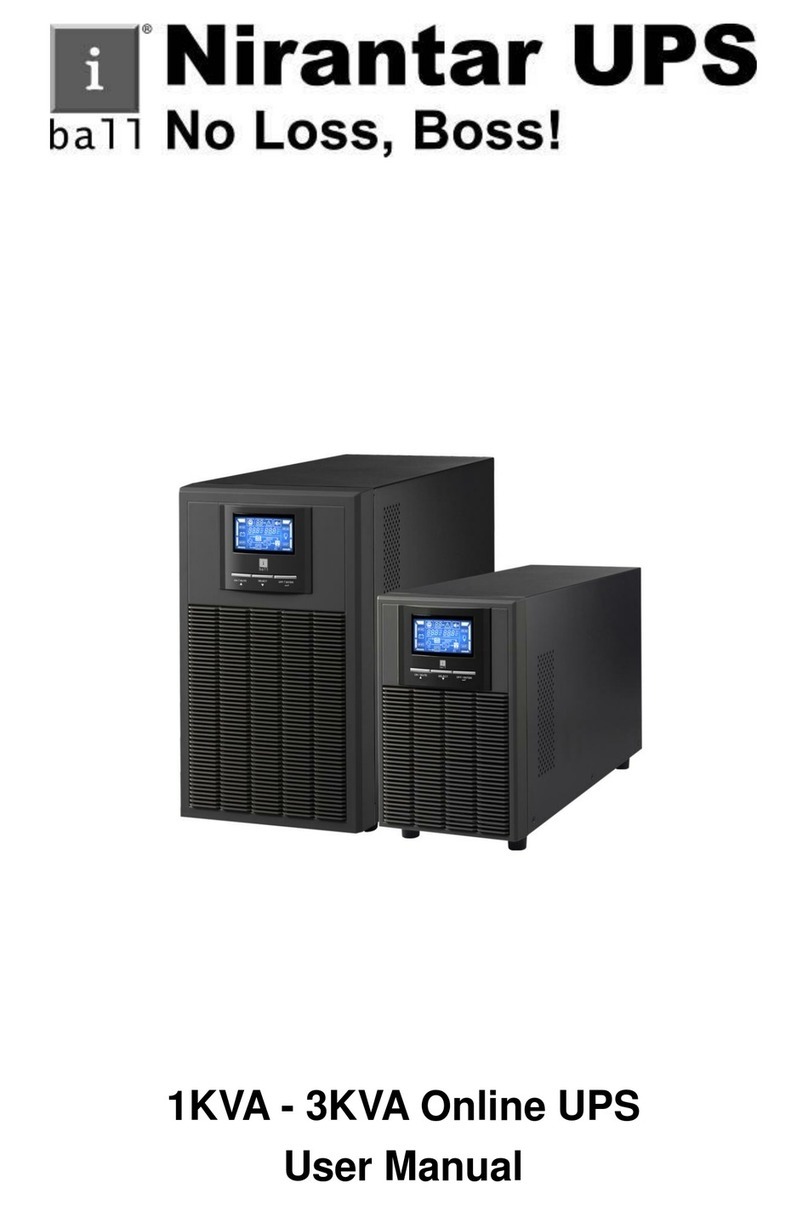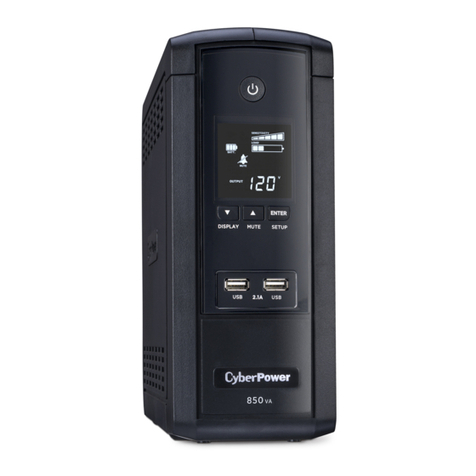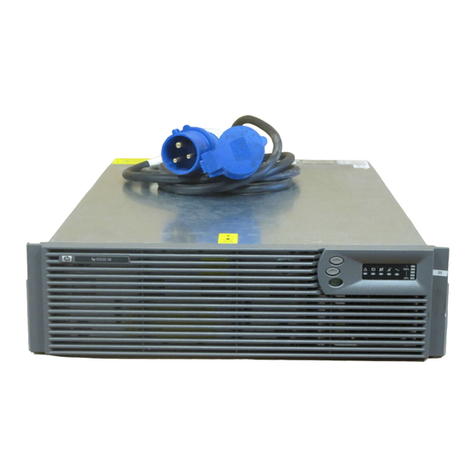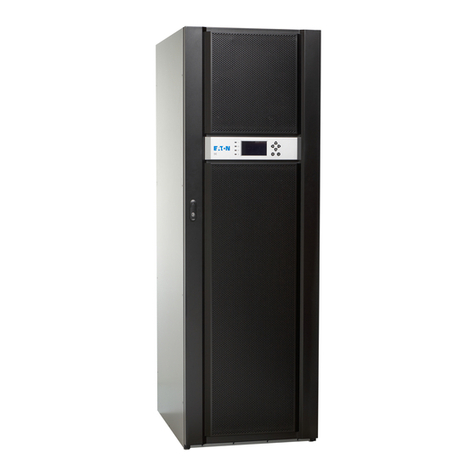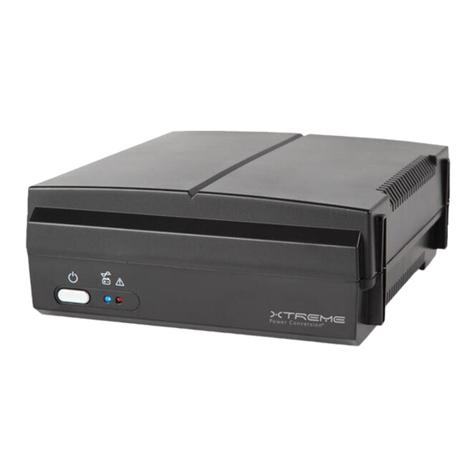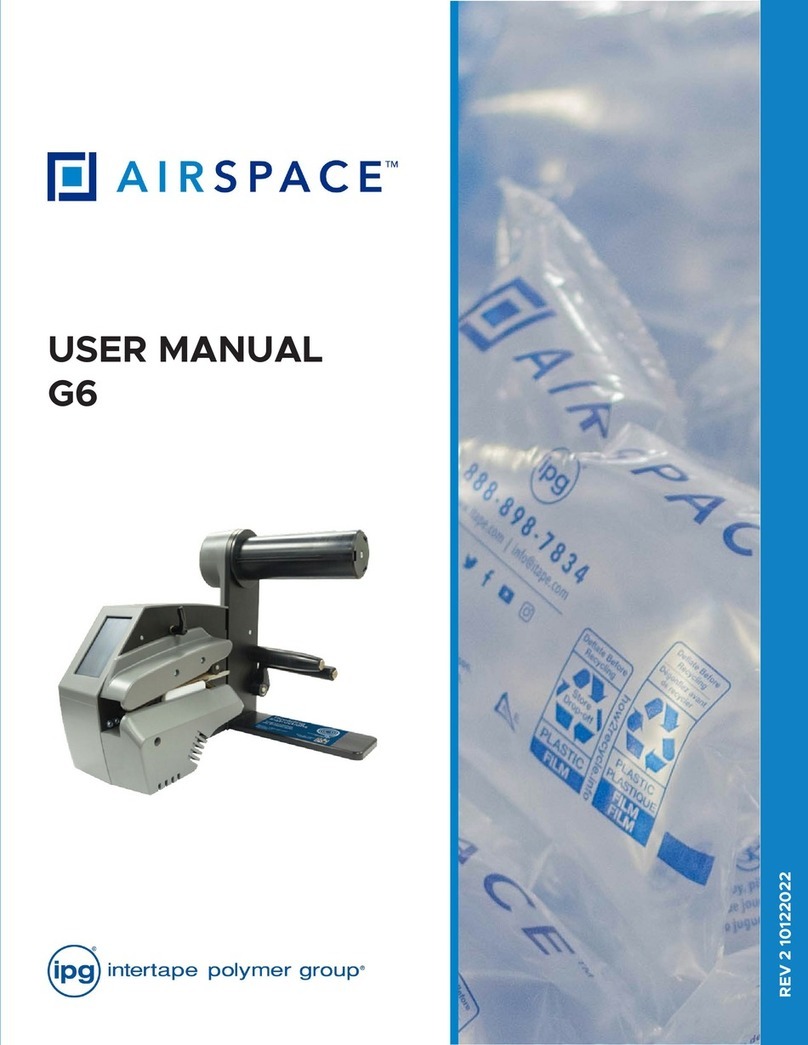Sicotec SLC-700-TWIN-RT2 User manual

SLC TWIN RT2
0,7.. 10 kVA
UNINTERRUPTIBLE POWER SUPPLY SYSTEMS (UPS)
USER MANUAL
Industriestrasse 17 Tel. 061 926 90 60 www.sicotec.ch
SICOTEC AG

2
General index
1. INTRODUCTION.
1.1. THANK YOU LETTER.
2. SAFETY INFORMATION.
2.1. USING THIS MANUAL.
2.1.1. Conventions and symbols used.
3. QUALITY ASSURANCE AND STANDARDS.
3.1. STATEMENT BY THE MANAGEMENT.
3.2. STANDARDS.
3.2.1. First and second environment.
3.2.1.1. First environment.
3.2.1.2. Second environment.
3.3. ENVIRONMENT.
4. PRESENTATION.
4.1. VIE WS.
4.1.1. Views of the device.
4.2. DEFINITION OF THE PRODUCT.
4.2.1. Nomenclature.
4.3. OPERATING PRINCIPLE.
4.4. UPS OPERATING MODES.
4.4.1. Notable features.
4.5. OPTIONAL EXTRAS.
4.5.1. Isolation transformer:
4.5.2. Exterior manual maintenance bypass.
4.5.3. Communication card.
4.5.3.1. Integration into computer networks using an SNMP adapter.
4.5.3.2. Modbus RS485.
4.5.3.3. Interface to relays.
4.5.4. Extendable guide kits for mounting in a rack cabinet.
5. INSTALLATION.
5.1. RECEPTION OF THE DEVICE.
5.1.1. Reception, unpacking and contents.
5.1.2. Storage.
5.1.3. Unpacking.
5.1.4. Transport to the site.
5.1.5. Siting, immobilising and considerations.
5.1.5.1. Rotation of the control panel with LCD display.
5.1.5.2. Vertical tower-type mounting.
5.1.5.3. Vertical tower-type mounting with backup extension (battery
module).
5.1.5.4. Mounting as a rack in a 19” cabinet.
5.1.5.5. Rack mounting in a 19” cabinet with backup extension
(battery module).
5.1.5.6. Vertical tower-type mounting with PDU.
5.1.5.7. Rack mounting in 19” cabinet with PDU.
5.1.5.8. Preliminary considerations before connection.
5.1.5.9. Preliminary considerations before connection, regarding the
batteries and their protections.
5.1.5.10. Connection elements.
5.2. CONNECTIONS.
5.2.1. Connection of the input.
5.2.2. Connection to IEC connectors or output terminals.
5.2.2.1. Connection of loads in models up to 3 kVA.
5.2.2.2. Connection of loads in 4 to 10 kVA 10 kVA.
5.2.3. Connection to external batteries (backup extension).
5.2.4. Connection of the input earth terminal ( ) and the earth
connection terminal ( ) .
5.2.5. Terminals for EPO (emergency power off).
5.2.6. Terminals for digital input and output to relay. Only in models
with power ratings > 3 kVA.
5.2.7. Manual bypass auxiliary contact terminals. Only in models with
power ratings > 3 kVA.
5.2.8. Connection in parallel, only in models with power ratings > 3
kVA.
5.2.8.1. Introduction in redundancy.
5.2.8.2. Installation and operation in parallel.
5.2.9. Communication port.
5.2.9.1. RS232 and USB port.
5.2.10. Smart slot for the integration of an electronic communication
unit.
5.2.11. Protection against voltage spikes for the modem / ADSL / fax,
etc., line. .
5.2.12. Software.
5.2.13. Considerations before start-up with connected loads.
6. OPERATION.
6 .1. S TA R T- U P.
6.1.1. Checks before start-up.
6.2. UPS START-UP AND SHUTDOWN.
6.2.1. UPS start-up with mains voltage.
6.2.2. UPS start-up without mains voltage.
6.2.3. UPS shutdown with mains voltage.
6.2.4. UPS shutdown without mains voltage.

3
6.3. OPERATING PROCEDURE FOR A PARALLEL SYSTEM (ONLY
IN 4 TO 10 KVA MODELS).
6.4. HOW TO ADD A UPS TO A SYSTEM IN PARALLEL
OPERATION OR TO A FUNCTIONING SINGLE UPS (ONLY IN 4
TO 10 KVA MODELS).
6.5. HOW TO REPLACE A FAULTY UPS IN AN OPERATIONAL
PARALLEL SYSTEM.
7. CONTROL PANEL WITH LCD DISPLAY.
7.1. GENERAL INFORMATION FOR THE SERIES.
7.1.1. Information represented by the display.
7.1.2. Common messages shown on the LCD display.
7.1.3. Common abbreviations shown on the display.
7.2. CONTROL PANEL FOR MODELS UP TO 3 KVA.
7.2.1. Composition of the control panel with LCD display.
7.2.2. Audible alarms.
7.2.3. Location of the adjustment parameters on the display.
7.2.4. Settings.
7.2.4.1. Ah configuration of parameter ‘12’.
7.2.4.2. Operating mode / Description of state.
7.2.4.3. Warning or alert codes.
7.2.4.4. Error or fault codes.
7.2.4.5. Warning or alert indicators.
7.3. CONTROL PANEL FOR 4 KVA TO 10 KVA MODELS.
7.3.1. Audible alarms.
7.3.2. Optical indications.
7.3.3. Location of the adjustment parameters on the display.
7.3.4. Settings.
7.3.4.1. Operating mode / Description of state.
7.3.4.2. Operating mode / Description of state.
7.3.4.3. Warning or alert codes.
7.3.4.4. Error or fault codes.
7.3.4.5. Warning or alert indicators.
8. MAINTENANCE, WARRANTY AND SERVICE.
8.1. BATTERY MAINTENANCE.
8.1.1. Notes for the installation and replacement of the battery.
8.2. UPS TROUBLESHOOTING GUIDE.
8.2.1. Troubleshooting guide for devices up to 3 kVA.
8.2.2. Troubleshooting guide for 4 kVA to 10kVA devices.
8.3. WARRANTY CONDITIONS.
8.3.1. Terms of the warranty.
8.3.2. Exclusions.
8.4. TECHNICAL SERVICES NETWORK.
9. ANNEXES.
9.1. GENERAL TECHNICAL SPECIFICATIONS.
9.2. GLOSSARY.
USER MANUAL

4
1. INTRODUCTION.
1.1. THANK YOU LETTER.
We thank you in advance for the trust placed in us in the
purchasing of this product. Read this instruction manual
carefully in order to familiarize yourself with its content,
since the more you know and understand the equipment the
greater your satisfaction, level of safety and optimization of its
functionalities will be.
We remain at your disposal for any additional information or
queries that you may wish to make.
•
The equipment described herein is capable of causing
significant physical damage in the event of improper
handling. For this reason its installation, maintenance and/
or repair must be carried out exclusively by our personnel or
by qualified personnel.
•
Although no effort has been spared to ensure that the
information in this user manual is complete and accurate, we
are not responsible for any errors or omissions that may exist.
The images included in this document are for illustrative
purposes and may not represent exactly the parts of the
equipment shown, therefore they are not contractual.
However, any divergence that may arise will be remedied or
solved with the correct labelling on the unit.
•
Following our policy of constant evolution, we reserve
the right to modify the characteristics, operations
or actions described in this document without prior
notice.
•
Reproduction, copying, assignment to third parties,
modification or total or partial translation of this manual
or document, in any form or by any means, without previous
written authorization by our firm is prohibited, with
the full and exclusive property rights over the same being
reserved by our firm.

5
2. SAFETY INFORMATION.
2.1. USING THIS MANUAL.
The documentation of any standard equipment is available to the
customer on our website for download (www.salicru.com).
•
For devices “powered by socket”, this is the website for
obtaining the user manual and “Safety Instructions”
EK266*08.
•
For devices with “permanent connection” via terminals, a
CD-ROM or pen drive containing all necessary information for
connection and start-up, including “Safety Instructions”
EK266*08, may be supplied with it.
Before carrying out any action on the device relating to its
installation or start-up, change of location, configuration or
handling of any kind, carefully read the safety instructions.
The purpose of the user manual is to provide information
regarding safety and explanations of the procedures for
installation and operation of the equipment. Read them carefully
and follow the steps indicated in the order established.
Compliance with the "Safety Instructions" is
mandatory and the user is legally responsible for
compliance and enforcement.
The equipment is delivered properly labelled for the correct
identification of each of the parts, which together with the
instructions described in this user manual allows the operations
of installation and commissioning to be performed in a simple
and orderly manner without having any doubts whatsoever.
Finally, once the equipment is installed and operating, it is
recommended to save the documentation downloaded from the
website, CD-ROM or Pen Drive in a safe and easy-to-access
place, for any future queries or doubts that may arise.
The following terms are used interchangeably in the document
to refer to:
•‘SLC TWIN RT2’, ‘TWIN RT2’, ‘TWIN’, ‘RT2’, ‘device’,
‘unit’ and ‘UPS’ - Uninterruptible power supply.
Depending on the context of the phrase, it can refer either
to the actual UPS itself or to the the UPS and the batteries,
regardless of whether it is all assembled in the same metal
casing - box - or not.
•“Batteries or accumulators”.- Group or set of elements
that stores the flow of electrons by electrochemical means.
•‘T.S.S.’ - Technical Service and Support.
•‘Client, installer, operator or user’ - These are used
interchangeably and by extension to refer to the installer
and/or operator who will carry out the corresponding
actions, and the same person may be responsible for
carrying out the respective actions when acting on behalf
of, or in representation of, same.
2.1.1. Conventions and symbols used.
Some symbols may be used and appear on the equipment,
batteries and/or in the context of the user manual.
For more information, see section 1.1.1 of document EK266*08
on "Safety instructions".
USER MANUAL

6
3. QUALITY ASSURANCE AND STANDARDS.
3.1. STATEMENT BY THE MANAGEMENT.
Our goal is customer satisfaction, therefore this Management
has decided to establish a Quality and Environment Policy,
through the implementation of a Quality and Environmental
Management System that will enable us to comply with the
requirements demanded in the ISO 9001 and ISO 14001 and
also by our Customers and Stakeholders.
Likewise, the management of the company is committed to the
development and improvement of the Quality and Environmental
Management System, through:
•Communication to the entire company of the importance of
satisfying both the client's requirements as well as legal
and regulatory requirements.
•The dissemination of the Quality and Environment Policy
and the setting of the Quality and Environment objectives.
•Conducting reviews by the Management.
•Providing the necessary resources.
3.2. STANDARDS.
The SLC TWIN RT2 is designed, manufactured and sold in
accordance with Quality Management Standard EN ISO 9001.
The marking indicates conformity with EC Directives
through the application of the following standards:
•2014/35/EU. - Low voltage safety.
•2014/30/EU. - Electromagnetic Compatibility - EMC-.
•2011/65/EU. - Restriction of the use of hazardous
substances in electrical and electronic equipment (RoHS).
According to the specifications of the harmonized standards.
Reference standards:
•
EN-IEC 62040-1. Uninterruptible Power Supplies -UPS-. Part
1-1: General and safety requirements for UPS used in user
access areas.
•
EN-IEC 60950-1. Information technology equipment. Safety.
Part 1: General requirements.
•
EN-IEC 62040-2. Uninterruptible Power Supplies -UPS-.
Part 2: EMC requirements.
The manufacturer accepts no liability in the event of
modification of or intervention on the device by the
user.
WARNING!:
SLC TWIN RT2 0.7.. 3 kVA. This is a category C2 UPS.
In a residential environment, this product may cause
radio interference, in which case the user must take
additional measures.
SLC TWIN RT2 4.. 10 kVA. This is a category C3 UPS. This
is a product for commercial and industrial application
in the second environment; Installation restrictions
or additional measures may be necessary to avoid
disturbances.
It is not appropriate to use this equipment in basic
life support applications (BLS), where a failure of the
former can render vital equipment out of service or
significantly affect its safety or effectiveness. It is also
not recommended in medical applications, commercial
transport, nuclear installations, or other applications
or loads, where a failure of the product can lead to
personal or material damages.
The EC declaration of conformity of the product is
available to the customer upon express request to our
headquarters.
3.2.1. First and second environment.
The environment examples that follow cover most UPS
installations.
3.2.1.1. First environment.
Environment including residential, commercial and light
industry installations, directly connected, without intermediate
transformers, to a low voltage public power grid.
3.2.1.2. Second environment.
An environment that includes all commercial, light industrial
and industrial establishments that are not directly connected
to a low voltage power grid supplying buildings used for
residential purposes.
3.3. ENVIRONMENT.
This product has been designed to respect the environment and
manufactured according to ISO 14001.
Recycling of the equipment at the end of its useful life:
Our company undertakes to use the services of authorized and
regulatory companies to treat the set of products recovered at
the end of their useful life (contact your distributor).
Packaging:
For the recycling of the packaging there must be compliance
with the legal requirements in force, according to the specific
regulations of the country where the equipment is installed.
Batteries:
Batteries pose a serious danger to health and the environment.
The disposal of them shall be carried out in accordance with
the laws in force.

7
4. PRESENTATION.
4.1. VIEWS.
4.1.1. Views of the device.
In Fig. 1 to Fig. 4, illustrations of the device are shown according
to box size in relation to the power rating of the model. However,
because the product is constantly evolving, discrepancies or
slight contradictions may arise. If in any doubt, the labelling on
the equipment itself will always prevail.
The nameplate of the device shows all of the values
relating to its main properties and characteristics. Act
accordingly for its installation.
0.7 to 3 kVA models
4 to 10 kVA models
Battery module for
0.7 to 10 kVA models
Control panel with
LCD display
Plastic front trim
Control panel with
LCD display
Plastic front trim
BATTERY LINEBYPASS FAULT
Fig. 1. Front view of 0.7 to 10 kVA models and their
battery modules for extended backups.
USER MANUAL

8
IEC output connectors programmable
at disconnection, for non-critical loads
Standard and B1 0.7
to 1.5 kVA models
COM port
USB
RS232
COM port
AC power IEC connector
Smart slot
protective cover
Fan
Input connector for modem/
ADSL/fax, etc., lines
Connector for
external EPO
Output connector, with protection
for modem/ADSL/fax, etc.
Connector for connection to
external battery module.
Earth
connection
Non-programmable IEC output
connectors, for critical loads
Standard and B1
2 kVA models
COM port
USB
RS232 COM
port
AC power IEC connector
Smart slot
protective cover
Fan
Input connector for modem/
ADSL/fax, etc., lines
Connector for
external EPO
Output connector, with protection
for modem/ADSL/fax, etc.
Non-programmable IEC output
connectors, for critical loads
Earth
connection
IEC output connectors programmable
at disconnection, for non-critical loads
Connector for connection to
external battery module.
Standard and B1
3 kVA models
COM port
USB
RS232 COM
port
AC power IEC connector
Smart slot
protective cover
Input connector for modem/
ADSL/fax, etc., lines
Connector for
external EPO
Fans
Output connector, with protection
for modem/ADSL/fax, etc.
16 A IEC output connector
Earth
connection
Non-programmable IEC output
connectors, for critical loads
IEC output connectors programmable
at disconnection, for non-critical loads
Connector for connection to
external battery module.
Communication bus for
parallel systems
4 to 10 kVA models
COM port
USB
RS232 COM
port
Connector for
external EPO
Smart slot
protective cover
Connector for connection to
external battery module.
Output, earth,
input terminals
Manual Bypass
auxiliary contact.
Current signal bus for
parallel systems
Input
switch
Digital
input/output
Fans
Standard 4 to 10 kVA
models, represented
with battery module
Fig. 2. Rear view of 4 to 10 kVA models.

9
Battery module input
connector
VDC protection
Battery module for
0.7 to 3 kVA devices
Output connector for
battery module
Earth connection
Battery module for 4
to 10 kVA devices
Battery module
connector
VDC protection
Battery module
connector
Fig. 3. Rear view of battery modules for extended backups.
PDU for 4 to 6 kVA
devices
Output circuit
breaker
Output IEC
connectors
Output circuit
breaker
Output IEC
connectors
PDU for 8 to 10 kVA
devices
Output circuit
breaker
Output IEC
connectors
Output IEC
connectors
Output IEC
connectors
Fig. 4. Front view of PDU (power distribution unit).
USER MANUAL

10
4.2. DEFINITION OF THE PRODUCT.
4.2.1. Nomenclature.
SLC-8000-TWIN RT2 B1 WCO EE29503
MOD BAT TWIN RT2 2x6AB003 40A WCO EE29503
EE* Special customer specifications.
CO 'Made in Spain' marking on UPS and packaging
(for customs purposes).
W Private-label device.
B0 Without batteries.
B1 Device with extra charger and without batteries.
TWIN RT2 Device series.
8000 Power in VA.
SLC Brand acronym (for UPS).
CF Frequency converter (device without batteries).
EE* Special customer specifications.
CO ‘Made in Spain’ marking on UPS and packaging
(for customs purposes).
W Private-label device.
40A Protection size.
003 Last three digits of the battery code.
AB Initials of the battery family.
6 Number of batteries in one branch.
2x Number of branches in parallel. Omit for one.
0/ Battery module without them, but with the
necessary accessories to install them.
TWIN RT2 Battery module series.
MOD BAT Battery module.
Note related to B0 and B1 batteries:
(B0) The device is supplied without batteries, but with
a space reserved for installation in the same box
for models whose standard version specifies this.
For other models, the battery pack will be installed
in the manner considered most appropriate (box,
cabinet, rack, etc.).
For B0 devices ordered, the cost of acquisition,
installation and connection of the batteries shall
always be borne by the customer or distributor
and under their responsibility.
Accessories such as screws, cables and battery
connection plates are considered optional and
can be supplied upon request.
(B1) Device with a more powerful charger, which does
not have a battery pack, nor the possibility of
installing them in the same box.
If an accumulator module is required, it will need
to be ordered as a separate item, which will be
connected to the UPS using the supplied cable.
Before connecting a module or group of batteries to the
device or another available module, it is necessary
to check that the voltage value printed on the back of
the device next to the battery connector is appropriate
and that the polarity between the means of connection
corresponds.
For more information, see Chapter 9 of this document.

11
4.3. OPERATING PRINCIPLE.
This manual describes the installation and operation of SLC
TWIN RT2 series UPSs as devices that can be independently
operated or connected in parallel (for models > 3 kVA). SLC
TWIN RT2 series UPSs ensure optimum protection of any
critical load, maintaining the supply voltage of the loads
between the specified parameters without interruption during
failure, deterioration or fluctuation of mains power, and come
in a wide range of models (from 0.7 kVA to 10 kVA), enabling
the end user to select the model that best suits his needs.
Thanks to their PWM (pulse width modulation) and double-
conversion technology, SLC TWIN RT2 series UPSs are compact,
cool, silent and high performance.
The double converter principle eliminates all mains power
disturbances. A rectifier converts the AC current of the mains
into DC current, thereby maintaining optimum battery charge
level and powering the inverter, which, in turn, generates a
suitable AC sine-wave voltage for continuously powering the
loads. In the event of failure of the UPS’s mains power, the
batteries supply clean power to the inverter.
The design and construction of the SLC TWIN RT2 series UPS
has been carried out in accordance with international standards.
In addition, models with power ratings greater than 3 kVA can
be expanded with the connection of additional modules with
the same power in parallel to obtain N+X redundancy or an
increase in the system’s power.
Thus, this series has been designed to maximise the availability
of critical loads and to ensure that your business is protected
from variations in power distribution line voltage, frequency,
electrical noise, cuts and micro-cuts. This is the primary goal of
SLC TWIN RT2 series UPSs.
This manual applies to the standardised models shown in Tab. 1.
4.4. UPS OPERATING MODES.
•Normal mode.
Device running supplying output voltage from the inverter.
Mains power present with correct input voltage and
frequency.
•Battery mode.
Device running with mains voltage or frequency out of
range or without AC input power, either due to mains
failure or absence of cable connection, supplying output
voltage from the batteries.
•Bypass mode.
Device running or not, supplying output voltage directly
from the AC mains.
With the inverter running, this operating mode may be
due to an overload, blockage or inverter fault.
The actions for each incident will be as follows: Reduce
the load connected to the output, unblock the device by
resetting it – stop it and start it up again – and, if the
blockage or fault remains, contact T.S.S.
With the inverter shut down, the output supplies mains
power directly through the static bypass of the device
provided that it has AC input power.
•Frequency converter (CF) mode.
Operating mode of the UPS as a frequency converter. In
this mode, the static bypass is disabled by the condition of
disparate input and output frequencies.
Even if the LCD display on the backlit control panel
shows messages, it does not mean that the inverter is
operational. It is switched on by pressing the ‘ON’
button on the control panel, see Chapter 6.
4.4.1. Notable features.
•True on-line with double-conversion technology and output
frequency separate from the mains.
•Output power factor 1, except for B1 models where it is 0.8.
Pure sine waveform, suitable for almost all kinds of loads.
•Input power factor > 0.99 and high overall performance
(between 0.89 and 0.91 for 0.7 to 3 kVA models and > 0.93
for higher power ratings). Greater energy savings and lower
user installation costs (wiring), as well as low distortion
of the input current, which reduces pollution in the power
supply network.
•Great adaptability to the worst conditions of the mains.
Wide input voltage, frequency and waveform ranges, thus
avoiding excessive dependence on limited battery power.
•Possibility of fast and easy backup extension by adding
modules in rack format. Each battery module has two
connectors for easy connection to the device and other
identical modules.
•Availability of battery chargers of up to 6 A to reduce bat-
tery recharge times.
•N+X redundant parallel connection to increase reliability
and flexibility in power models > 3 kVA, with a maximum
of 3 devices in parallel.
•Selectable high-performance mode (ECO MODE) > 0.95 to
0.99 depending on model. Energy savings, economically
beneficial for the user.
•Possibility of starting the device without mains power
supply or discharged battery. Be careful with this aspect
because the greater the batteries are discharged, the more
the backup will be reduced.
•Intelligent battery management technology is very useful
for extending the life of accumulators and optimising
recharge times.
•Standard communication options via the RS232 serial port
or USB port.
•Digital input for device Start/Stop and ‘Error or fault’ digital
output in models with power ratings > 3 kVA.
•Remote emergency power off control (EPO).
•Control panel with LCD display available on all models and
LED indicators on devices with power ratings > 3 kVA.
•Availability of optional connectability cards to improve
communication capabilities.
•Device that can be installed as a tower or rack using the
accessories supplied. The control panel can be rotated to
adapt to either format.
USER MANUAL

12
Model Type Input/output type
SLC-700-TWIN RT2
Standard
Single-phase / Single-phase.
SLC-1000-TWIN RT2
SLC-1500-TWIN RT2
SLC-2000-TWIN RT2
SLC-3000-TWIN RT2
SLC-4000-TWIN RT2
SLC-5000-TWIN RT2
SLC-6000-TWIN RT2
SLC-8000-TWIN RT2
SLC-10000-TWIN RT2
SLC-700-TWIN RT2 (B0)
Without batteries
SLC-1000-TWIN RT2 (B0)
SLC-1500-TWIN RT2 (B0)
SLC-2000-TWIN RT2 (B0)
SLC-3000-TWIN RT2 (B0)
SLC-4000-TWIN RT2 (B0)
SLC-5000-TWIN RT2 (B0)
SLC-6000-TWIN RT2 (B0)
SLC-8000-TWIN RT2 (B0)
SLC-10000-TWIN RT2 (B0)
SLC-700-TWIN RT2 (B1)
Long backup with additional charger
SLC-1000-TWIN RT2 (B1)
SLC-1500-TWIN RT2 (B1)
SLC-2000-TWIN RT2 (B1)
SLC-3000-TWIN RT2 (B1)
SLC-4000-TWIN RT2 (B1)
SLC-6000-TWIN RT2 (B1)
SLC-8000-TWIN RT2 (B1)
SLC-10000-TWIN RT2 (B1)
Tab. 1. Standardised models.
4.5. OPTIONAL EXTRAS.
Depending on the configuration chosen, the device may include
any of the following options:
4.5.1. Isolation transformer:
The isolation transformer provides galvanic isolation in order
to completely isolate the output from the input and/or change
neutral mode.
The placement of an electrostatic screen between the primary
and secondary windings of the transformer provides a high
level of electrical noise attenuation.
The isolation transformer can be physically placed at the input
or output of the UPS depending on the technical conditions of
the whole system (device supply voltage and/or load voltage,
characteristics or their type, etc.).
In parallel systems, it is not possible to operate with independent
transformers for each UPS; on the contrary, it is necessary to
have a single common element for the total adequate power.
In any event, it will always be supplied as a peripheral
component external to the device itself in a separate box.
4.5.2. Exterior manual maintenance bypass.
The purpose of this option is to electrically isolate the device
from the mains and the critical loads without cutting the power
to the latter. In this way, maintenance or repair operations on
the device can be carried out without interruptions to the power
supply of the protected system, while preventing unnecessary
hazards for the technical personnel.
4.5.3. Communication card.
The UPS features a slot at the rear for inserting one of the
following communication cards.
4.5.3.1. Integration into computer networks using an SNMP
adapter.
Large computer systems based on LANs and WANs that
integrate servers in different operating systems must provide
the system manager with ease of control and administration.
This facility is obtained through an SNMP adapter, which
is universally supported by the main software and hardware
manufacturers.
Connection of the UPS to the SNMP is internal while that of
the SNMP to the computer network is made through a RJ45 10
base connector.
4.5.3.2. Modbus RS485.
Large computer systems based on LANs and WANs often
require that communication with any element that is integrated
into the computer network be made through a standard
industrial protocol.
One of the most used standard industrial protocols on the
market is the MODBUS protocol.
4.5.3.3. Interface to relays.
•The UPS has, as an option, an interface to relays card
that provides digital signals in the form of potential-free
contacts, with a maximum applicable voltage and current
of 240 V AC or 30 V DC and 1A.
•This communication port enables dialogue between the
device and other machines or devices through the relays
supplied in the terminal block arranged on the same card,
with a single common terminal for all of them.
From the factory, all contacts are normally open and can
be changed one by one, as indicated in the information
supplied with the optional extra.
•The most common use of these types of ports is to provide
the necessary information to the file-closing software.
•For more information, contact our T.S.S. or our nearest
distributor.
4.5.4. Extendable guide kits for mounting in a rack cabinet.
An extendable and unique guide kit is available for all device
models, valid for any kind of rack-type cabinet.
These guides allow the installation of any TWIN RT2 device
unit and possible battery modules in the case of extended
backups, as if it were a rack in its respective cabinet.

13
5. INSTALLATION.
•Read and respect the Safety Information, described
in chapter 2 of this document. Failure to obey some
of the instructions described in this manual can result in a
serious or very serious accident to persons in direct contact
or in the vicinity, as well as faults in the equipment and/or
loads connected to it.
•In addition to the device’s own user manual, other
documents are supplied on the CD-ROM or documentation
pen drive. Consult them and strictly follow the indicated
procedure.
•Unless otherwise indicated, all actions, instructions,
guidelines and notes are applicable to the devices, whether
or not they form part of a parallel system.
5.1. RECEPTION OF THE DEVICE.
•Pay attention to section 1.2.1. of the safety instructions
-EK266 * 08- in all matters relating to the handling, move-
ment and location of the unit.
•Use the most suitable means to move the UPS while it is
packed, with a transpalet or forklift.
•Any handling of the device must be carried out in accordance
with the weights shown in the technical specifications
according to the model, indicated in chapter ‘9. Annexes’.
5.1.1. Reception, unpacking and contents.
•Reception. Check that:
The data on the label affixed to the packaging
correspond to those specified in the order. Once the
UPS is unpacked, check the previous data with those of
the equipment nameplate.
If there are discrepancies, file the disagreement as
soon as possible, citing the equipment manufacture
number and the delivery note references.
It has not suffered any mishaps during transportation
(packaging and impact indicator in perfect condition).
Otherwise, follow the protocol indicated on the label
attached to the impact indicator, located on the
packaging.
•Unpacking.
To check the contents, it will be necessary to remove
the packaging.
Complete the unpacking according to the
procedure of section 5.1.3. Content.
•Content
0.7 to 3 kVA device:
–1 UPS.
–Quick guide on paper.
–Information for warranty registration.
–1 USB cable.
–3 cables with IEC connectors for loads.
–1 cable for the device’s AC power supply.
–2 metal pieces for use as handles and screws for
installing the unit in a rack cabinet.
–4 plastic pieces for use as a base to facilitate
the arrangement of the UPS as a tower (vertical
position).
Optional battery module for 0.7 to 3 kVA UPS:
–1 battery module.
–Information for warranty registration.
–2 metal pieces for use as handles and screws for
installing the unit in a rack cabinet.
–2 plastic pieces to extend the base of the UPS and
enable the arrangement of the attached battery
module in its mounting as a tower.
–1 cable for interconnecting the battery module and
UPS or other module.
4 to 10 kVA device:
–1 UPS.
–1 PDU module (power distribution unit).
–Information for warranty registration.
–2 metal pieces for use as handles and screws for
installing the UPS in a rack cabinet.
–2 metal pieces for use as handles and screws for
installing the PDU in a rack cabinet.
–1 metal piece and screws for mounting the PDU
attached to the UPS arranged as a tower.
–1 USB cable.
–4 plastic pieces for use as a base to facilitate
the arrangement of the UPS as a tower (vertical
position).
–1 cable for connecting the communication bus.
Useful only for connection to a parallel device.
–1 cable for connecting the current bus. Useful only
for connection to a parallel device.
–1 cable for interconnecting the battery module and
UPS.
4 to 10 kVA battery module:
–1 battery module.
–Information for warranty registration.
–2 metal pieces for use as handles and screws for
installing the unit in a rack cabinet.
–2 plastic pieces to extend the base of the UPS and
enable the arrangement of the attached battery
module in its mounting as a tower.
–1 cable for interconnecting the battery module and
another module.
•Once the reception is completed, it is advisable to re-pack
the UPS until it is put into service in order to protect it
against mechanical shock, dust, dirt, etc.
•The packaging of the device consists of a wooden pallet,
cardboard or wooden box, depending on the item, expanded
polystyrene corners, polyethylene cover and strapping, all
of which are recyclable materials. When the packaging
requires disposal, it must be carried out in accordance with
current laws.
We recommend keeping it for at least 1 year.
5.1.2. Storage.
•
The device should be stored in a dry, ventilated room and
protected from rain, dust, and water or chemical splashes. It
is advisable to keep each device and battery unit in its orig-
inal packaging, as it has been specifically designed to en-
sure maximum protection during transportation and storage.
•For devices that contain Pb-Ca batteries, the
charging times indicated in Tab. 2 of document
EK266*08, determined by the temperature to which they
USER MANUAL

14
are exposed, must be respected, otherwise the warranty
may be invalidated.
•After this period, connect the device to the mains together
with the battery unit if applicable, start it according to the
instructions described in this manual and charge for 12
hours.
In parallel systems, it is not necessary to interconnect
devices before battery charging. Each of them can be
treated independently to charge them.
•Then shut down the device, disconnect it and store the UPS
and batteries in their original packaging, noting the new
date for recharging the batteries on a document as a record
or even on the packaging itself.
•Do not store the devices where the ambient temperature
exceeds 50ºC or drops below -15ºC, as this may cause
degradation of the electrical characteristics of the batteries.
5.1.3. Unpacking.
•The packaging of the device consists of a cardboard box,
expanded polystyrene (EPS) or polyethylene foam (EPE)
corners, polyethylene cover and strapping, all of which are
recyclable materials; consequently, if it requires disposal,
it must be carried out in accordance with current laws. We
recommend keeping the packaging in case it needs to be
used in the future.
•Proceed as follows:
Cut the straps around the cardboard box.
Remove the accessories (cables, brackets, etc. )
Remove the device or battery module from the box with
the help, if necessary, of a second person depending
on the weight of the model or using appropriate
mechanical means.
Remove the protective corners from the device and the
plastic bag.
Do not leave the plastic bag within the reach of
children to avoid danger of suffocation.
Inspect the device before proceeding and, in the event
of finding damage, contact the supplier or, failing that,
our firm.
5.1.4. Transport to the site.
It is recommended to transport the UPS by means of a
pallet jack or the most appropriate method considering the
distance between the two points.
If the distance is considerable, it is recommended to
transport the device in its packaging to the installation site
and then unpack it.
5.1.5. Siting, immobilising and considerations.
•All TWIN RT2 series UPSs are designed to be mounted as
a tower model -vertical arrangement of the device- or rack
-horizontal arrangement- for installation in 19” cabinets,
regardless of whether they operate independently or as
parallel systems, whether or not they have a battery module
or whether the available backup is standard or extended
(greater number of battery modules).
Follow the instructions indicated in the sections relating to
either of the two possibilities, according to the particular
configuration of your device.
•Figs. 5 to 11 show, by way of example, illustrations of a
device with or without battery module. These illustrations
provide help and guidance in the steps to follow, but the
instructions are not intended to refer to a single model,
although, in practice, the actions to be carried out are
always the same for all of them.
•
For all instructions regarding connections, refer to section 5.2.
5.1.5.1. Rotation of the control panel with LCD display.
Fig. 5. Rotation of the control panel with LCD display on
the plastic front trim.
•To facilitate the reading of messages on the display when
the device is installed vertically, it is possible to rotate the
control panel clockwise by 90º (see Fig. 5).
•Likewise, reverse the rotation of the control panel if a
device arranged as a tower needs to be installed as a rack.
In this case, the rotation of the control panel will be anti-
clockwise.
•Proceed as follows:
Insert fingertips into the recesses of the plastic trim
around the display and pull outwards.
Rotate the control panel with LCD display 90º to the
right with respect to its initial position and insert it back
into the front.
5.1.5.2. Vertical tower-type mounting.
•Rotate the control panel according to section 5.1.5.1.
•Take the 4 pieces of plastic supplied with the device and
join them together in twos to obtain two bases.
•Place the UPS upright between the two bases at a distance
of 70 mm from each end (see Fig. 6).

15
and install them to obtain two bases to hold the device and
the battery module.
•Place the UPS and battery module upright between the two
bases (see Fig. 7) and at a distance of 70 mm from each
end, similar to as shown in Fig. 7.
Fig. 7. Vertically mounted tower-type model with backup
extension (battery module).
5.1.5.4. Mounting as a rack in a 19” cabinet.
•To mount a device in a 19” rack cabinet, proceed as follows
(see Fig. 8):
Using the supplied screws, fix the two adapter angles
for use as handles on each side of the UPS, respecting
your hand.
To install the device in a rack cabinet, it is necessary
to have internal lateral guides for use as supports.
Alternatively, and upon request, we can supply
universal slides for use as guides, for installation by
the user.
Mount the guides at the required height, ensuring
correct tightening of the fixing screws and appropriate
fitting in the machining, according to each case.
Place the device onto the guides and insert it all the
way to the back.
Depending on the device model and weight, and/or
whether it is installed in the upper or lower part of the
cabinet, it is recommended that two people carry out
the installation operations.
Fix the UPS to the cabinet frame using the screws
supplied with the handles.Fig. 6. Vertical tower-type mounting.
5.1.5.3. Vertical tower-type mounting with backup extension
(battery module).
•The description in this section refers to a device with a
single battery module. For a greater number, proceed in a
similar way.
•Rotate the control panel according to section 5.1.5.1.
•Take the 4 plastic pieces in the form of an angle supplied
with the UPS and the two supplied with the battery module,
USER MANUAL

16
Fig. 8. Rack-type mounting in a 19” cabinet.
5.1.5.5. Rack mounting in a 19” cabinet with backup extension
(battery module).
•This section describes a device with one battery module.
For more battery modules, repeat the same procedure for
each of them.
•To install a device and its battery module in a 19” rack
cabinet, proceed as follows (see Fig. 9):
Using the supplied screws, fix the two adapter angles
for use as handles on each side of the UPS, respecting
your hand. Repeat the same procedure for the battery
module.
To install each unit, UPS and battery module in a rack
cabinet, it is necessary to have internal lateral guides
for use as supports. Alternatively, and upon request,
we can supply universal slides for use as guides, for
installation by the user.
Mount the guides at the required height, ensuring
correct tightening of the fixing screws and appropriate
fitting in the machining, according to each case.
Place the device onto the guides and insert it all the
way to the back. Proceed in the same way for the
battery module.
Depending on the weight of each unit according to the
type of device and battery module, and/or whether it is
installed in the upper or lower part of the cabinet, it is
recommended that two people carry out the installation
operations.
Fix the UPS and the battery module to the cabinet frame
by means of the screws supplied with the respective
handles.
Fig. 9. Rack-mounted model in a 19” cabinet with
backup extension (battery module).
5.1.5.6. Vertical tower-type mounting with PDU.
4 to 10 kVA models are supplied as standard with a PDU
module, designed to be attached to the side of the device.
Fix it to the UPS using the plate supplied as a support as shown
in Fig. 10.
Fig. 10. Vertically mounted tower-type model with PDU.
5.1.5.7. Rack mounting in 19” cabinet with PDU.
Similar to the UPS, the PDU module has angles for use as
handles for mounting in a rack cabinet.
•Proceed as follows (see Fig. 11):
Using the supplied screws, fix the two adapter angles
for use as handles on each side of the PDU, respecting
your hand.
According to each case, perform the steps indicated in
section 5.1.5.4 or 5.1.5.5.
To install the PDU in a rack cabinet, it is necessary to
have internal lateral guides for use as supports, just
like for the UPS and/or battery module. Follow the
guidelines described in section 5.1.5.4 or 5.1.5.5 for
everything related to the guides.
Place the PDU onto the guides and insert it all the way
to the back.
Fix it to the cabinet frame using the screws supplied
with the handles.

17
Fig. 11. Rack-type mounting in a 19” cabinet with PDU.
5.1.5.8. Preliminary considerations before connection.
•In the description of this manual, reference is made to the
connection of terminals and switch operations that are
only available in some versions or devices with extended
backup. Ignore the related operations if your unit does not
feature them.
•Thermal control of these devices is carried out with the
passage of forced air from the front to the rear.
The front surface and about 15 cm on the rear side should
be left free of obstructions to facilitate the free circulation
of air for ventilation.
•Follow and respect the instructions described in this section
referring to the installation of a single device or a system
in parallel.
•Protection or external manual bypass board:
The system will have at least one short-circuit
protection on the UPS’s power supply line.
It is advisable to have an external manual bypass board
fitted with input, output and manual bypass protections
in single systems.
For parallel systems, it is essential to have a
distribution or manual bypass board. The board’s
circuit breakers must be able to isolate a UPS from
the system in the event of a fault and power the loads
with the others, either during periods of preventative
maintenance or during breakdown and repair.
•Upon request, we can supply an external manual bypass
board for a single device or parallel system.
You can also choose to manufacture it, taking into account
the version and configuration of the device or system
available and the documentation contained in the CD-ROM
or pen drive relating to ‘Recommended installation’.
•In the documentation supplied with this user manual
and/or on the CD-ROM or pen drive, information is
available on ‘Recommended installation’ for each input and
output configuration. This documentation includes wiring
diagrams and information about the sizes of the protections
and the minimum cross sections of cables connected to the
device according to their rated working voltage. All values
are calculated for a maximum total cable length of 30 m
between the distribution board, equipment and loads.
For longer lengths correct the cross sections to avoid
voltage drops, respecting the regulations or standards
corresponding to the country.
In the same documentation and for each configuration,
information for ‘N’ units in parallel, as well as backfeed
protection characteristics, is available.
•In parallel systems, the length and cross section of
the cables that run from the distribution or manual
bypass board to each UPS and from these to the board will
be the same for all of them without exception.
•The cross section of the cables must always be considered
in relation to the size of the terminals of the switches, so
that they are correctly fastened across their entire cross
section for optimum contact between the two elements.
•Only rated currents are printed on the nameplate of the
equipment as indicated by the EN-IEC 62040-1 safety
standard. For the calculation of the input current, the power
factor and the equipment's own performance have been
considered.
Overload conditions are considered a non-permanent
and exceptional working mode, and will not be taken
into account in the application of the protections. Do not
connect appliances or devices which may overload the UPS
to the terminals and/or outlets, such as motors.
•If peripheral input, output or bypass elements such as
transformers or autotransformers are added to the UPS or
parallel system, the currents indicated on the nameplates of
these elements must be taken into consideration in order to
use the appropriate cross sections, in compliance with local
and/or national Low Voltage Electrotechnical Regulations.
•When a galvanic isolation transformer is added to a UPS
or parallel system as an optional extra, as standard or
independently, either on the input line, at the output or
both, it must be fitted with protection against indirect
contact (differential circuit breaker) at the output of each
transformer, since, due to its own insulation properties, it
will prevent the tripping of the protections placed on the
primary of the isolation transformer in case of electric shock
on the secondary (output of the isolation transformer).
•We remind you that all the isolation transformers installed
or factory supplied, have the output neutral grounded
through a bridge between the neutral terminal and ground.
If the isolated output neutral is required, this bridge must be
removed, taking the precautions indicated in the respective
local and/or national low voltage regulations.
•This device is suitable for installation in networks
with TT, TN-S, TN-C or IT power distribution
systems, taking into account at the time of installation the
particularities of the system used and the national electrical
regulations of the destination country.
•The SLC TWIN RT2 features terminals for the installation
of an external emergency power off button (EPO) or, failing
that, a single device must be installed to cut the power
supply to the loads in any operating mode.
5.1.5.9. Preliminary considerations before connection, regarding
the batteries and their protections.
•SLC TWIN RT2 devices from 0.7 to 3 kVA incorporate the
batteries in the same box as the device, except for B0, B1
and higher power models.
•The battery protection of the device and of any accumulator
module is always by means of internal fuses that are not
accessible to the user.
USER MANUAL

18
•IMPORTANT FOR SAFETY: If batteries are installed
independently, the accumulator group must be fitted
with a bipolar circuit breaker or disconnect fuse of the size
indicated in Tab. 2.
•Inside the battery module, there are HAZARDOUS
VOLTAGES with risk of electric shock, so it is classified as a
RESTRICTED ACCESS AREA.
•Do not handle the fuse holder or battery circuit
breaker when the device is running.
•If the mains power of the device or parallel system
is cut for longer than a simple intervention and it is
expected that it will be out of service for a prolonged period
time, the system must be shut down completely.
•The battery circuit is not isolated from the input
voltage. Dangerous voltages can occur between the
terminals of the battery group and the earth. Check that
there is no input voltage before intervening on the terminals.
5.1.5.10. Connection elements.
•All of the device’s electrical connections are made from the
back of each unit:
Input and output connection.
–For models up to 3 kVA.
Input by means of a cable with plug, connectable to
the UPS through an IEC connector.
Outputs through IEC connectors.
–For models with power ratings greater than 3 kVA.
Terminals for powering the device and loads.
It is necessary to remove the transparent protective
cover to access the terminals.
Replace the cover after making the
connections to prevent possible accidents
due to direct contact, especially in tower mountings
as there is a greater risk.
Connection to batteries.
–The device and battery module have a polarised
connector.
Remove the screws and protective cover of the
connector before interconnecting it.
–All battery modules have two connectors that
enable backup extension.
Communication connectors available:
–DB9 for RS232. In models up to 3 kVA, the interface
to relays signals are supplied with the same
connector.
–USB to operate the UPS as a PC peripheral.
–Digital input and output (only in models > 3 kVA).
–For connection to external EPO button.
–Auxiliary contact for the manual bypass switch
(only in models > 3 kVA).
DB15 communication bus connectors and analogue
current signal block for connecting systems in parallel
(only in models > 3 kVA).
To access the signal block, it is necessary to remove its
protective cover.
Slot for the integration of one of the optional electronic
communication units. Remove the fixing screws and
plastic cover to enable it to be inserted.
•It is recommended to use terminals on all of the ends of
the cables connected to power terminals (input and output).
•Check that the terminal screws are correctly tightened.
5.2. CONNECTIONS.
5.2.1. Connection of the input.
•0.7 to 3 kVA models:
Take the power cable with plug and IEC connector on
the end and insert the latter into the input connector
of the UPS.
Plug the power cable into an AC power socket.
•4 to 10 kVA models:
As the device has Class I protection against
electric shock, it is essential to install a
protective earth conductor (connect earth ( )).
Connect this conductor before supplying voltage to the
input terminals.
Connect the power cables to the input terminals
respecting the order of the phase (R) and the
neutral (N) indicated on the labelling of the device and in
this manual. Pay particular attention when connecting
the power cables to the input terminals and do not
reverse the connection to the output terminals or vice
versa. Failure to respect the order will result in faults.
Where there are discrepancies between the labelling
and the instructions in this manual, labelling shall
always prevail.
In accordance with safety standard EN-IEC 62040-1, the
facility must be equipped with an automatic backfeed
protection system, such as a contactor, which prevents
the appearance of hazardous voltage or power on the
UPS input line during a mains failure (see Fig. 12).
The standard applies to both individual units and all
UPSs in parallel systems.
There can be no derivation of the line that goes
from the backfeed protection to the UPS, as this
would breach the safety standard.
Warning labels shall be affixed to all primary power
switches installed in areas remote from the equipment
to alert electrical maintenance personnel of the
presence of a UPS in the circuit.
The label shall bear the following text or an equivalent:
Before working on the circuit.
•Isolate the uninterruptible power supply system
(UPS).
•Check the voltage between all terminals, including
the protective earth.
Return voltage risk of the UPS.

19
(3)
(2)
(1)
UPS
Input
Output
R (L)
U (L)
N
N
(1) Automatic backfeed protection system external to the UPS (EN-IEC 62040-1).
(2) Fuse holder and general purpose fuse 250V AC / 3A type F.
(3) 230V AC bipolar contactor with minimum contact spacing of 1.4 mm and coil
with same voltage and the minimum current indicated on the nameplate of
the UPS (input or bypass as appropriate).
For parallel systems, each device must have its own separate backfeed
protection.
Fig. 12. Backfeed protection wiring diagrams.
5.2.2. Connection to IEC connectors or output terminals.
•SLC TWIN RT2 devices feature female IEC output connectors
or terminals depending on the power of the model:
Models up to 2 kVA: 2 groups of 4 x 10A IEC
connectors identified as «OUTPUT» and «OUTPUT
PROGRAMMABLE (P1)», configurable through the
control panel and/or ViewPower.
3 kVA models: same connectors as models up to 2 kVA
and an additional 16A IEC connector.
4 to 10 kVA models: 1 group of output terminals.
In these models, a PDU (power distribution unit) is
supplied to connect to the output terminals of the
UPS. Through it, loads can be powered directly through
the two or three groups of 10 or 16 A IEC connectors
protected by a selective circuit breaker.
•Do not connect loads that in their entirety exceed
the specifications of the device, as this would cause
inconvenient cuts in the power supply of the loads
connected to the output.
•If, in addition to the more sensitive ‘critical loads’, it is
necessary to connect high-consumption inductive loads,
such as for laser printers or CRT monitors, the starting up
of these peripherals will need to be taken into account to
prevent the device from crashing.
We do not recommend connecting loads of this type due to
the amount of power they absorb from the UPS.
5.2.2.1. Connection of loads in models up to 3 kVA.
•Connect the loads to the 10 A IEC connectors.
It is important to consider the two groups of IEC
connectors available, those for ‘critical loads’ and
those for ‘non-critical loads’.
By definition, ‘critical loads’ are considered to be those
that can cause economic damage if they stop functioning
or function incorrectly.
The IEC connectors indicated in Fig. 2 as ‘non-critical
loads’ can be programmed as such through the control
panel. In this case, the backup of the batteries for the
loads connected to the IEC connectors indicated in Fig. 2 as
‘critical loads’ will be reserved. Take into account that they
are set by default as ‘critical loads’.
•The 3 kVA models also have a 16A IEC connector
that enables the connection of a load of the total
power of the device.
5.2.2.2. Connection of loads in 4 to 10 kVA 10 kVA.
•As the device has Class I protection against electric
shock, it is essential to install a protective earth
conductor (connect earth ( )). Connect this conductor
before supplying voltage to the input terminals.
•Connect the loads to output terminals U (L) and N,
respecting the order of the phase and the neutral
indicated on the labelling of the device and in this manual
(see Fig. 2). Where there are discrepancies between the
labelling and the instructions in this manual, labelling shall
always prevail.
•Together with the device, a PDU with several 10 and 16A
IEC output connectors with their respective circuit breaker
is supplied.
When the utility of the PDU is required to power the loads,
it will be necessary to connect its input cables to the output
of the UPS, respecting the following assignment:
Black or brown cable to phase U (L).
Red or blue cable to neutral (N).
Green-yellow cable to earth terminal ( ).
•
With regard to the protection that must be placed at the
output of the UPS when the PDU is not used, we recommend
distributing the output power over at least four lines. Each of
them will have a circuit breaker with a value of one quarter
of the rated power. This type of output power distribution
will allow that in the event of a fault in any of the machines
connected to the equipment, which provokes a short circuit,
does not affect more than the line that is broken.
The remaining connected loads will have continuity
assured due to the tripping of the protection, only in the
line affected by the short circuit.
5.2.3. Connection to external batteries (backup extension).
•Failure to comply with the instructions in this
section and Safety Instructions EK266*08 car-
ries a high risk of electric shock and even death.
•SLC TWIN RT2 devices from 0.7 to 3 kVA incorporate the
batteries in the same box as the device, except for B0, B1
and higher power models.
•The battery protection of the device and of any accumulator
module is always by means of internal fuses that are not
accessible to the user.
•IMPORTANT FOR SAFETY: If batteries are installed
independently, the accumulator group must be fitted
with a bipolar circuit breaker or disconnect fuse of the size
indicated in Tab. 2.
USER MANUAL

20
Model Rated voltage
of batteries
Minimum values,
fast type fuses
DC voltage (V) Current (A)
SLC-700-TWIN RT2
(12 V x 3) = 36 V
125
20
SLC-1000-TWIN RT2 32
SLC-1500-TWIN RT2
50SLC-2000-TWIN RT2 (12 V x 4) = 48 V
SLC-3000-TWIN RT2 (12 V x 6) = 72 V
SLC-4000-TWIN RT2
(12 V x 16) = 192V 400
20
SLC-5000-TWIN RT2 32
SLC-6000-TWIN RT2
SLC-8000-TWIN RT2 40
SLC-10000-TWIN RT2 50
Tab. 2. Protection features between device and battery
module.
•Before starting the connection process between
battery module or modules and device, check that
the device and loads are ‘Off’.
Also, when the batteries are installed by the user
independently, the protection fuse or isolator must be
deactivated.
•Connection of the battery module to the device is made by
means of a cable featuring polarised connectors at both
ends, which is supplied with the first one. Two connectors
are available for this purpose on the device and battery
module.
Similarly, the battery modules feature two connectors that
allow the linking of modules in parallel.
•Each battery module is independent for each device.
Two devices must not be connected to the
same battery module.
Likewise, in parallel systems (4 to 10 kVA models), with
each device connected to its battery module or modules,
they should be considered as single devices that are
independent of each other.
•Fig. 13 shows the connection of a 10 kVA device in a
rack arrangement with two battery modules. For a larger
number, proceed in a manner similar to those shown in the
illustration.
Fig. 13. Connection to battery modules.
5.2.4. Connection of the input earth terminal ( ) and the
earth connection terminal ( ) .
•As the device has Class I protection against electric
shock, it is essential to install a protective earth
conductor (connect earth ( )). Connect this conductor
before supplying voltage to the input terminals.
•
Make sure that all of the loads connected to the UPS are only
connected to its earth connection terminal ( ). Failure to
limit the earthing of the load or loads and battery module or
modules to this single point will create earth return loops
that will degrade the quality of the power supplied.
•All terminals identified as an earth connection ( ) are
connected to each other, to the earth terminal ( ) and to
the device’s earth.
5.2.5. Terminals for EPO (emergency power off).
•The UPSs have two terminals for the installation of an
external emergency power off (EPO) output button.
•The device is dispatched from the factory with its EPO
circuit set to closed (NC) by default. In other words, the
UPS will cut the output power supply, emergency power
off, when the circuit is opened:
Either by removing the female connector from the socket
where it is inserted. This connector has a cable connected
as a jumper that closes the circuit (see Fig. 14-A).
Or by pressing the button external to the device
belonging to the user installed between the terminals
of the connector (see Fig. 14-B). The connection on the
button must be in the normally closed contact (NC), so
it will open the circuit when activated.
The reverse functionality can be selected through the
communications software and control panel.
Except for specific cases, we advise against this type
of connection in view of the purpose of the EPO button,
since it will not act upon an emergency request if either
of the two cables that run from the button to the UPS is
accidentally cut.
By contrast, this anomaly would immediately be detected
in a closed EPO circuit, with the inconvenience of an
unexpected cut in the powering of the loads, but a
guarantee of effective emergency functionality.
•To recover the normal operating state of the UPS, it is
necessary to insert the connector with the jumper in its
receptacle or deactivate the EPO button. The device will
be operational.
A B
Fig. 14. Connector for external EPO.
This manual suits for next models
8
Table of contents
Other Sicotec UPS manuals

